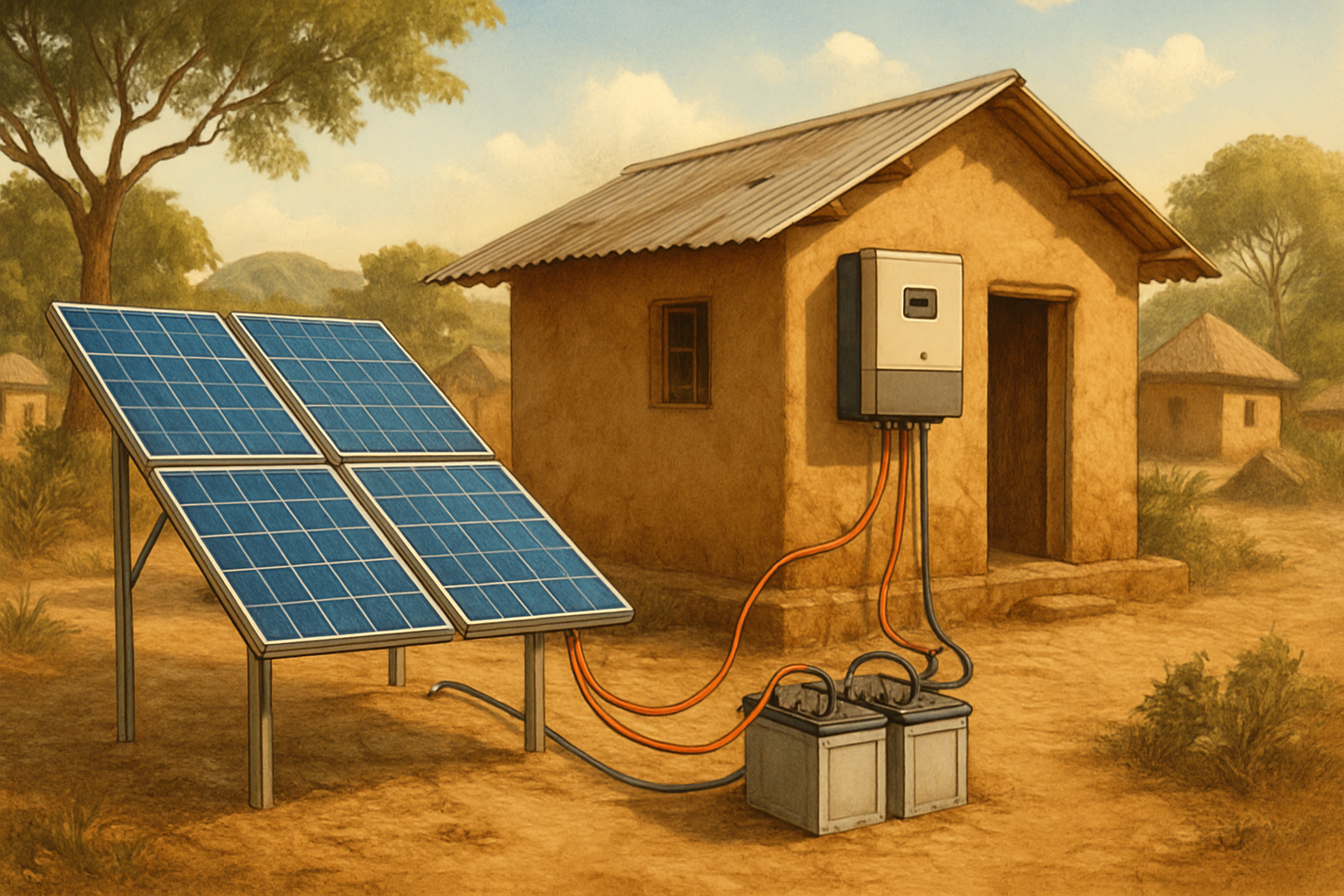Many believe off-grid solar cannot meet the demanding energy needs of industrial operations. This perception often stems from outdated views on solar technology. Modern solar and energy storage systems offer robust, reliable, and scalable power solutions, even for heavy industry in remote locations. You can achieve energy independence and operational efficiency with these advanced systems.

The Evolving Landscape of Industrial Power Needs
Industrial operations, especially in remote communities, face unique energy challenges. Access to a stable, affordable power grid is often limited or non-existent. This forces many to rely on costly and environmentally impactful alternatives.
Limitations of Traditional Grid and Diesel
Connecting to a national grid in remote areas can be prohibitively expensive. Even with grid access, power quality might be inconsistent, leading to downtime and equipment damage. For decades, diesel generators have filled this gap, providing power where the grid falls short. However, diesel comes with significant drawbacks. Fuel transportation is costly and logistically complex, especially to isolated sites. Fuel price volatility directly impacts operational budgets, making long-term financial planning difficult. Additionally, diesel generators contribute to air and noise pollution, posing environmental and health concerns.
The Drive for Energy Independence and Sustainability
Businesses are increasingly seeking sustainable and independent energy solutions. This shift is driven by a desire to reduce operational costs, minimize environmental impact, and secure a reliable power supply. Renewable energy, particularly solar, provides a compelling alternative. According to Renewable Energy for Industry, these sources can replace fossil fuels used to generate power or mechanical force for remote, off-grid industrial facilities. This move towards self-sufficiency offers stability against energy market fluctuations and supports corporate sustainability goals.
How Off-Grid Solar Powers Industrial Operations
An off-grid industrial solar system is more than just solar panels. It is a sophisticated integration of technologies designed to deliver consistent power. These systems are engineered to handle significant and often fluctuating industrial loads.
Key Components and Their Roles
- Solar Panels (PV): These convert sunlight into direct current (DC) electricity. Modern panels offer high efficiency and durability, performing well even in challenging environments.
- Lithium Iron Phosphate Batteries (LiFePO4): High-performance, safe, and reliable lithium iron phosphate batteries store excess solar energy. This stored energy becomes crucial during periods of low sunlight or high demand, ensuring continuous operation.
- Hybrid Inverters: These devices convert the DC electricity from solar panels and batteries into alternating current (AC) electricity, which most industrial equipment uses. Hybrid inverters efficiently manage power flow between solar, batteries, and sometimes a backup generator, optimizing energy use.
- Energy Management System (EMS): An intelligent EMS monitors and controls the entire system. It optimizes energy generation, storage, and consumption, ensuring maximum efficiency and reliability for industrial processes.
System Design Considerations for Industrial Loads
Designing an off-grid solar system for industry requires careful planning. You must accurately assess the facility's total energy consumption, peak load requirements, and critical operational hours. This includes understanding the power demands of heavy machinery, motors, and other specialized equipment. The system must be sized to meet these demands, incorporating sufficient solar generation capacity and battery storage to provide autonomy for several days, if needed. For instance, the Electricity Storage Valuation Framework highlights that the Ta’u Island microgrid provides three days of autonomy, drastically reducing diesel generator usage. This level of planning ensures the system can handle significant loads and maintain continuous operation.
Real-World Applications and Benefits
Off-grid solar solutions are already transforming various industrial sectors. They offer tangible economic savings, environmental advantages, and enhanced operational reliability.
Case Studies: Mining, Agriculture, and Manufacturing
In the mining sector, remote sites often incur massive costs for diesel fuel transportation. Implementing off-grid solar can drastically cut these expenses, providing a stable power supply for extraction, processing, and camp facilities. Agricultural operations, such as large-scale irrigation systems or processing plants in isolated regions, also benefit. Solar-powered pumps reduce reliance on fossil fuels, lowering operational costs and increasing sustainability. For manufacturing facilities situated far from urban centers, off-grid solar offers a path to energy independence, ensuring consistent production without grid interruptions. An example is the Alpine Knits cotton mill in India, which installed a 1 MWp PV hybrid solution to reduce diesel usage, as noted in the Electricity Storage Valuation Framework.
Economic Savings and Environmental Impact
The financial benefits of off-grid industrial solar are substantial. You eliminate fuel costs, reduce maintenance expenses associated with generators, and gain predictability in energy expenditures. Over the lifespan of the system, these savings can amount to millions. Environmentally, off-grid solar significantly reduces carbon emissions, air pollutants, and noise pollution. This aligns with global sustainability goals and enhances a company's corporate social responsibility profile. A shift to solar also reduces the risks associated with transporting and storing fossil fuels.
| Factor | Diesel Generator | Off-Grid Solar + Storage |
|---|---|---|
| Fuel Cost | High & Volatile | Near Zero |
| Maintenance | High (Engine, filters, oil) | Low (Minimal moving parts) |
| Emissions | High CO2, NOx, Particulates | Zero Operational Emissions |
| Noise Level | High | Very Low |
| Reliability | Dependent on fuel supply & maintenance | High (with proper sizing & storage) |
| Scalability | Limited by generator size | Highly scalable with modular components |
Overcoming Challenges and Ensuring Reliability
While off-grid solar for industry presents many advantages, addressing potential challenges is key to successful implementation. Modern technology and expert planning mitigate risks effectively.
Addressing Intermittency with Advanced Storage
Solar power is intermittent; it depends on sunlight. This is a common concern for industrial applications requiring constant power. Advanced battery storage systems, particularly those using lithium iron phosphate technology, overcome this. They store surplus energy generated during peak sunlight hours and discharge it when solar generation is low or demand is high. This ensures a stable and continuous power supply. Intelligent energy management systems further optimize this process, predicting energy needs and managing battery charge and discharge cycles efficiently. The Getting Wind and Solar onto the Grid report mentions that discussions of variable renewable energy (VRE) integration are sometimes rife with misconceptions, highlighting the need for accurate information on how these systems operate reliably.
Maintenance and Long-Term Operational Excellence
Long-term reliability depends on proper system design, quality components, and effective maintenance. Modern solar panels and lithium batteries require minimal maintenance compared to diesel generators. Regular inspections, cleaning of solar panels, and monitoring of battery performance ensure optimal operation. Reputable providers offer comprehensive maintenance plans and remote monitoring capabilities, allowing for proactive issue resolution. This focus on operational excellence ensures that industrial off-grid solar systems deliver consistent, reliable power for decades.
A Sustainable Path Forward
The idea that off-grid solar cannot power industry is a myth. You can achieve robust, reliable, and sustainable energy for industrial operations in remote communities with today's advanced solar and storage technologies. By embracing off-grid solar solutions, businesses gain energy independence, reduce operational costs, and contribute to a cleaner environment. The transition to renewable energy is not just an environmental imperative; it is a strategic business decision that offers long-term benefits and resilience.
Frequently Asked Questions
What types of industries can benefit from off-grid solar?
Many industries can benefit, including mining, agriculture, manufacturing, telecommunications, tourism, and remote research facilities. Any operation in an area with limited or no grid access, or high energy costs, is a strong candidate.
How does off-grid solar handle heavy machinery and fluctuating loads?
Off-grid systems are designed with powerful inverters and sufficient battery storage to manage peak loads and sudden power demands from heavy machinery. An intelligent Energy Management System (EMS) balances power generation and consumption, ensuring stability.
What is the typical lifespan of an industrial off-grid solar system?
Solar panels typically have a lifespan of 25-30 years, with minimal degradation. High-quality lithium iron phosphate batteries can last 10-15 years or more, depending on usage and maintenance. Inverters usually require replacement every 10-15 years.
Is off-grid solar more expensive than diesel generators in the long run?
While the initial investment for off-grid solar can be higher, the long-term operational costs are significantly lower due to the elimination of fuel expenses and reduced maintenance. Over its lifespan, an off-grid solar system typically offers a much lower total cost of ownership compared to continuous diesel generator use.
Do off-grid solar systems require a backup generator?
While a well-designed off-grid solar system with adequate battery storage can provide 100% of power needs, some industrial applications opt for a small backup generator for extreme emergencies or prolonged periods of unusually low solar irradiance. This creates a hybrid system, offering maximum redundancy.





Leave a comment
All comments are moderated before being published.
This site is protected by hCaptcha and the hCaptcha Privacy Policy and Terms of Service apply.